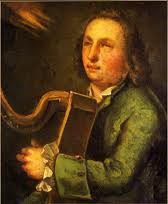Annotation:Grace Nugent
X:1 T:Grace Nugent by Carralan M:C| L:1/8 R:Air B:Neal – Collection of the Most Celebrated Irish Tunes (1724, p. 26) K:Ador A2E2A2B2|c2c2B2 AG|e2A2 dcBA|T^G4 {F}E4|cBcd c2d2| edef g2e2|a2e2 dcBA|1 A4 A4:|2 A4A2||:ef|g2g2 gagf| g2G2G2 fg|a2a2 abag|a2A2A2 ab|c’2c2 cdec|c’2 c2c2e2| d2c2TB3A/B/|G4 TE3 e/f/|g2d2 defd|g2d2d2 fg|a2e2 efge| a4 Tf3e/f/|g2c2g2 fg|a2e2d2c2|TB2A2 GABG|1 A4A2:|2 A4A4:|]
GRACE NUGENT. Irish, Air or Planxty. G Dorian (Tnompson): A Minor/Dorian (Bunting, Neal, Wright). Standard tuning (fiddle). AB. One of the early compositions of O'Carolan [1] (1670-1738) from the period he was residing with one of his first patrons, George Reynolds Esq., of Letterfyan. The year was 1693, O'Carolan was age 23, and Grace was the first cousin of Squire Reynolds. She was also the fifth and youngest daughter of James Nugent of Castle Nugent, Westmeath, records O'Sullivan (1958), and married her neighbor, Edward Crofton. However, at the time Carolan composed the air Grace was unmarried and living with her siter, Mrs. Conmee (for whom Carolan composed "Elizabeth Nugent"), according to a letter from Charles O'Conor in 1785. The tune was published in Daniel Wright's Arva di Camera, London, 1727. Later in the century the Scottish poet Robert Burns used the tune for his song "Louis, what reck I by Thee?" The Belfast Northern Star of July 15th, 1792, recorded that the tune was played by one of ten harp masters at the last great convocation of ancient Irish harpers, the Belfast Harp Festival, held that week.

The melody, as O'Sullivan points out, is based on the familiar English air "British Grenadiers (The)," which dates to the 16th century and predates Carolan's composition. John Mulholland's version (Ancient Irish Airs, 1810) [2] is nearly identical with Edward Bunting's version in the first strain, but differs somewhat in the second.
